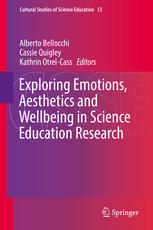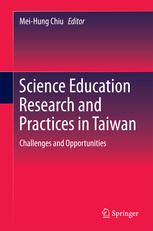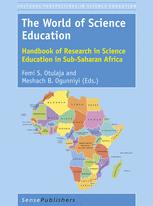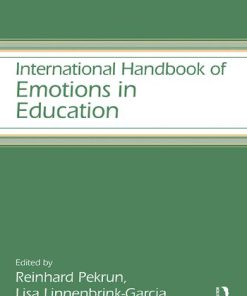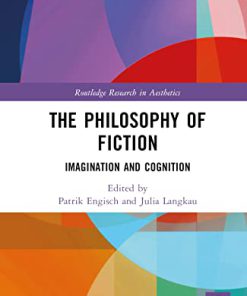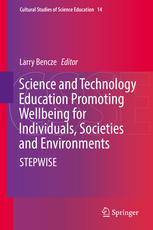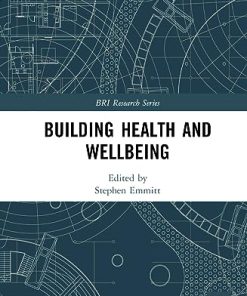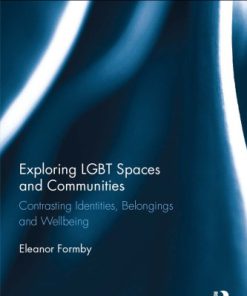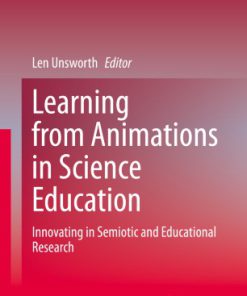Exploring Emotions Aesthetics and Wellbeing in Science Education Research 1st Edition by Alberto Bellocchi ISBN 3319433539 9783319433530
$50.00 Original price was: $50.00.$25.00Current price is: $25.00.
Exploring Emotions Aesthetics and Wellbeing in Science Education Research 1st Edition by Alberto Bellocchi – Ebook PDF Instant Download/Delivery: 3319433539, 9783319433530
Full download Exploring Emotions Aesthetics and Wellbeing in Science Education Research 1st Edition after payment
Product details:
ISBN 10: 3319433539
ISBN 13: 9783319433530
Author: Alberto Bellocchi
This book addresses new research directions focusing on the emotional and aesthetic nature of teaching and learning science informing more general insights about wellbeing. It considers methodological traditions including those informed by philosophy, sociology, psychology and education and how they contribute to our understanding of science education. In this collection, the authors provide accounts of the underlying ontological, epistemological, methodological perspectives and theoretical assumptions that inform their work and that of others. Each chapter provides a perspective on the study of emotion, aesthetics or wellbeing, using empirical examples or a discussion of existing literature to unpack the theoretical and philosophical traditions inherent in those works. This volume offers a diverse range of approaches for anyone interested in researching emotions, aesthetics, or wellbeing. It is ideal for research students who are confronted with a cosmos of research perspectives, but also for established researchers in various disciplines with an interest in researching emotions, affect, aesthetics, or wellbeing.
Exploring Emotions Aesthetics and Wellbeing in Science Education Research 1st Table of contents:
Chapter 1: Emotions, Aesthetics and Wellbeing in Science Education: Theoretical Foundations
1.1 The Need for Emotion, Aesthetics and Wellbeing in Science Education Research
1.1.1 Organization of the Book
References
Part I: Aesthetics in Science Education
Chapter 2: Back to the Drawing Board: Examining the Philosophical Foundations of Educational Res
2.1 Introduction
2.1.1 Analytic and Synthetic Traditions
2.2 Analytically Oriented Research on Aesthetic Experience
2.2.1 Neuroscience, Cognitive Science, and Psychology
2.2.2 Science Education
2.3 Basic Assumptions of Analytic Approaches
2.4 Emotion and Aesthetics in Synthetic Philosophy
2.4.1 Wittgenstein and the Meaning of Language
2.4.2 Dewey on Inquiry and the Principle of Continuity
2.5 Science Education Research with Synthetic Tendencies
2.6 Conclusions
References
Chapter 3: Taste for Science: A Bourdieu-Pragmatism Approach to Interest, Aesthetics and Learnin
3.1 Students’ Interest in Science
3.1.1 Attitudes and Identity
3.1.2 Interest as Representation
3.2 An Action-Oriented Perspective on Students’ Interest in Science
3.2.1 Interest as Constituted in Action
3.2.2 Interest as Taste
3.3 Analysing the Constitution of Taste in Classroom Action
3.4 Supporting a Taste for Science
3.4.1 Making the Norms of the Classroom a Shared Concern
3.4.1.1 Implicit Norms of the Science Classroom
3.4.1.2 Clarifying How Norms Are Conducive to Purposes
3.4.2 Making Everyday Distinctions of Taste Continuous with the Scientific Purposes of the Clas
3.4.2.1 Who and What Belong in the Science Classroom
3.4.2.2 Acknowledging and Negotiating Personal Judgements of Taste
3.5 Summary and Concluding Remarks
References
Chapter 4: The Heart of the Educator: Aesthetic Experience Shaping Knowledge, Identity, and Passi
4.1 Introduction
4.2 Dewey’s Aesthetics
4.3 Aesthetic Understanding
4.4 Specialist Primary Science Teacher
4.4.1 Hazel
4.4.2 KIP Summary
4.5 Preservice Science Teachers
4.5.1 Erin
4.5.2 Bryony
4.5.3 KIP Summary
4.6 The Marine Educator
4.6.1 Patrick
4.6.2 KIP Summary
4.7 Aesthetic Experiences That Lead to an Aesthetic Understanding: What Is Common?
4.7.1 Passion for the Work of Educating
4.7.2 A Connection with the Knowledge and Pedagogy of Science
4.7.3 An Identity That Is Developing
4.8 Practical Applications of the Aesthetic Understanding Framework
4.9 Methodological Possibilities and Limitations
4.10 Conclusions
References
Part II: Emotion and Affect in Science Education
Chapter 5: Interaction Ritual Approaches to Emotion and Cognition in Science Learning Experiences
5.1 Part 1: Sociology of Emotion and Interaction Rituals for Science Education Research
5.1.1 Interaction Ritual Theory
5.1.2 Empirical Studies of IRT in Science Education
5.1.3 Summary of Part 1
5.2 Part 2: What Else Can We Learn About Science Learning Through IRT?
5.2.1 A Social Epistemology of Religious Ideas
5.2.2 Establishing a Social Epistemology of Knowledge
5.2.3 Feelings and Ideas of Sacred Forces
5.2.4 Social Practices as the Origins of Categories of the Understanding
5.3 Part 3: Science Learning as Durkheimian Ritual Practices
5.3.1 Social Bonds and Social Solidarity
5.4 Toward a Microsociology of Learning (Science)
5.4.1 Lived/Enacted Curriculum
5.4.2 Future Directions for Microsociology of Learning in Science Education Research
5.4.3 Concluding Remarks
References
Chapter 6: Emotional Events in Learning Science
6.1 Contextualizing Emotional Events
6.2 History of Events
6.3 Reframing Event
6.4 Investigating Classroom Events: An illustrative Case
6.5 Implications for Classroom Research
Appendix: Transcript Conventions
References
Chapter 7: Emotions, Social Beings, and Ethnomethods: Understanding Analogical Reasoning in Everyd
7.1 Introduction
7.2 Analogical Reasoning and School Science Context
7.3 Ontology, Human Dualism, and Analogical Reasoning
7.3.1 A Priori Ontology
7.3.2 Empiricist Ontology
7.4 The Sense of Social Being
7.5 Emotional Energy as a Collective, Lived Experience
7.6 Emotional Energy and Moral Force
7.7 Social Practices as Ethnomethods
7.8 Ethnomethodology and Undramatic Emotional Energy
7.9 Respect
7.10 Objectivity as Respect for Objects
7.11 Summary and Implications
References
Chapter 8: Our Neighborhood: A Place for Heightening Emotional Energy in Science Education
8.1 Engagement in Terms of Emotional Energy
8.2 Place-Based Pedagogy as a Context for Engagement
8.3 Investigating Emotional Energy Through Place-Based Curricula
8.3.1 Context
8.3.2 Participants
8.3.3 Data Collection
8.3.4 Data Analysis
8.3.5 Validity
8.4 Emotional Energy in Place-Based Curricula
8.5 Place-Based Curriculum Fostered Emotional Energy
8.6 Potential Impact as a Critical Element to Emotional Energy
8.7 Conclusion
8.7.1 Implications
References
Chapter 9: Emotions: Connecting with the Missing Body
9.1 Introduction
9.2 Introducing Maurice Merleau-Ponty: Consciousness and Perception
9.2.1 Merleau-Ponty on Emotions
9.2.2 The Habitual Body: The Body’s Relationship with the Environment
9.2.3 The Body Defined Through Its Permanency
9.2.4 Emotions as Styles of Conduct
9.3 Examining Emotions Through Bodily Stance
9.4 The Investigation
9.5 Vignette 1: Risky Running
9.5.1 Applying Merleau-Ponty to “Risky Running”
9.6 Vignette 2: The Confident Runner
9.6.1 Applying Merleau-Ponty to “The Confident Runner”
9.7 Emotional Atmosphere
9.8 Discussion
9.9 Conclusion
9.10 Appendix: Transcript Conventions
References
Chapter 10: Interest and Emotions in Science Education
10.1 Introduction
10.2 Interest and Emotions
10.2.1 Interest as a Facilitator for Learning
10.3 Interest Development in Theoretical Perspectives
10.3.1 Interest as Disposition
10.3.2 Interest as Interestingness
10.3.3 Interest as a Psychological State
10.4 Connecting the Domains of Interest
10.5 Cases
10.5.1 Learning to be Interested: The Case of Animal Physiology
10.5.2 Learning to be Interested: The Case of Simulating Natural Selection
10.6 Perspectives of Focusing on Interest Development
References
Chapter 11: Science and the Arts: Curriculum Integration, Learning, and Emotions in Schools
11.1 Introduction
11.2 Opposites?
11.3 The Arts and Sciences in Learning
11.4 Art Making Is Discovery and Research
11.5 Tinkering Pedagogy
11.5.1 Tinkering
11.5.2 Movement
11.5.3 Learning Outputs
11.6 The Role of Emotions When Arts and Sciences Merge
References
Part III: Wellness and Wellbeing in Science Education
Chapter 12: Jin Shin Jyutsu and Ameliorating Emotion, Enhancing Mindfulness, and Sustaining Produc
12.1 Authentic Inquiry
12.1.1 Ontological Authenticity
12.1.2 Educative Authenticity
12.1.3 Catalytic Authenticity
12.1.4 Tactical Authenticity
12.2 Sociocultural Perspectives
12.3 Multilogicality
12.4 Researching Emotions
12.5 Jin Shin Jyutsu
12.6 Event-Oriented Inquiry
12.7 Enacting the Role of Critic
12.7.1 JSJ-Like Touches and Holds
12.8 Writing Activity
12.9 Anna as a Student in Class
12.10 What Did We Learn and How Did We Change as a Result of This Study?
12.11 Next Steps
References
JSJ Resources
Chapter 13: The Role of Care in Environmental Education
13.1 Exploring an Ethic of Care in Environmental Education
13.2 Conceptualizing an Ethic of Care in Environmental Education
13.3 Cultivating Care in an Environmental Science Classroom: Investigation of Aedes Mosquito
13.4 Understanding Care-Based Influences in Science: Unpacking the Investigation of Aedes Mosquit
13.5 Translating an Ethic of Care for Environmental Education
13.6 Implications and Complications of Teaching Care for the Environment
13.7 Future Directions for an Ethic of Care in Environmental Education
References
Chapter 14: Afterword: Science Education and Promises of Aesthetics, Emotion and Wellbeing
14.1 An Angle of Arrival
14.2 Assembling the Collection
14.3 Venturing Beyond Cartesian’s Grasp
14.3.1 What Might Aesthetics Offer Science Education?
14.3.2 What Might Emotion and Affect Offer Science Education?
14.3.3 What Might Wellness and Wellbeing Offer Science Education?
14.4 The Politics and Promises of A-E-W in Science Education
14.5 Partialities and Future Possibilities
People also search for Exploring Emotions Aesthetics and Wellbeing in Science Education Research 1st:
exploring emotions aesthetics and wellbeing in science
exploring emotions aesthetics and wellbeing in science education research
exploring emotional health
exploring aesthetic
exploring emotions by paul christelis
Tags:
Alberto Bellocchi,Exploring Emotions,Aesthetics,Wellbeing,Science Education
You may also like…
Science (General)
Education Studies & Teaching
Education Studies & Teaching
Politics & Philosophy - Social Sciences
International Handbook of Emotions in Education 1st Edition Reinhard Pekrun (Editor)
Politics & Philosophy - General & Miscellaneous Philosophy
The Philosophy of Fiction Routledge Research in Aesthetics 1st Edition Engisch
Education Studies & Teaching
Uncategorized
Politics & Philosophy
Education Studies & Teaching - School Education & Teaching


